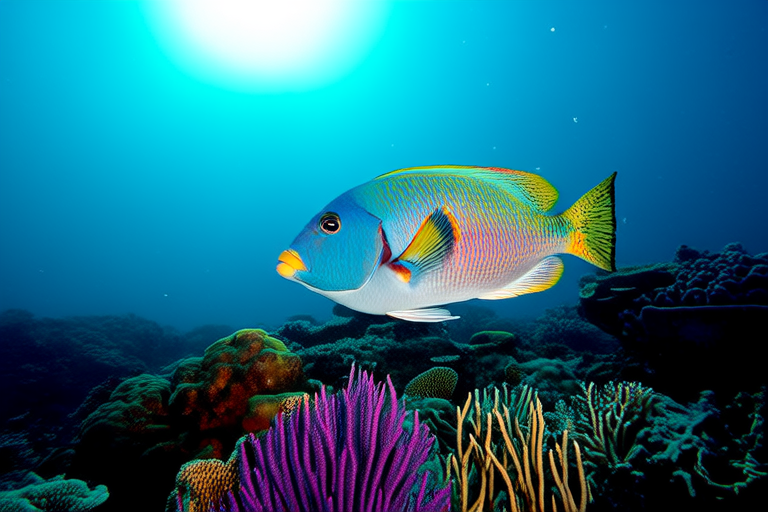The Secret Life of Parrot Fish: What You Didn’t Know About Them
Parrot fish, with their vibrant colors and unique appearance, are some of the most striking inhabitants of the ocean. These fish, named for their beak-like mouths, are not only visually stunning but also play crucial roles in maintaining the health of coral reefs. This article delves into the secret life of parrot fish, exploring their habitats, feeding habits, sleeping behaviors, social structures, and the challenges they face in today’s oceans.
Unique Appearance and Habitat
Parrot fish are known for their bright, often iridescent colors that range from electric blues and greens to fiery oranges and yellows. Their namesake beak-like mouth, equipped with strong teeth, allows them to scrape algae off coral reefs. They inhabit tropical and subtropical waters around the world, primarily residing in coral reefs, which serve as both their homes and primary food sources.
These reefs, teeming with life, provide shelter and sustenance for parrot fish. The warm, clear waters of the Caribbean, the Pacific, and the Indian Ocean are prime habitats where parrot fish can thrive. Their striking appearance and the rich biodiversity of their environment make them a favorite subject for divers and underwater photographers.
Feeding Habits: Guardians of Coral Reefs
One of the most remarkable aspects of parrot fish is their feeding habits. Using their powerful beaks, they scrape algae off coral surfaces, a process that is essential for maintaining the health of coral reefs. By consuming algae, they prevent it from overgrowing and smothering the coral polyps. In doing so, they indirectly support the entire ecosystem that relies on healthy coral reefs.
Parrot fish are also known for their contribution to sand production. After digesting the algae, they excrete the calcium carbonate skeletons of the corals, which eventually contribute to the formation of sandy beaches. Thus, these fish play a vital role in shaping the landscapes of tropical islands and coastlines.
Sleeping Behaviors: The Mucus Cocoon
Parrot fish have developed an intriguing sleeping behavior that offers protection from predators. At night, many species of parrot fish secrete a thick, gelatinous mucus cocoon around themselves. This cocoon acts as a shield, masking their scent and providing a barrier against parasites and potential predators. This behavior is a testament to the ingenuity of marine life in adapting to their environment.
The mucus cocoon is believed to be produced by a gland near the fish’s anus, and its composition includes proteins and sugars. While the exact chemical makeup varies among species, all parrot fish produce this protective layer during sleep, ensuring their survival through the night.
Complex Social Structures and Communication Methods
Parrot fish exhibit complex social structures within their communities. Many species live in large schools, and their interactions are intricate and varied. These schools can consist of hundreds of individuals, with distinct hierarchies and roles. Some parrot fish act as scouts, constantly surveying their surroundings for threats or new feeding opportunities, while others focus on reproduction and care of offspring.
Communication within these schools is also sophisticated. Parrot fish use a combination of visual signals, body movements, and sounds to convey information. For example, certain body postures can signal aggression or submission, while specific sounds might alert other members of the school to potential dangers. Understanding these communication methods provides insights into the social dynamics of these fish and highlights the complexity of marine ecosystems.
Conservation Efforts and Threats
Despite their importance to marine ecosystems, parrot fish populations face numerous threats. Overfishing, habitat destruction, and climate change pose significant risks to their survival. Coral reefs, the primary habitat for parrot fish, are under threat due to rising sea temperatures and increased acidity, which can lead to coral bleaching and death. As reefs degrade, the parrot fish lose their homes and food sources.
Efforts to conserve parrot fish populations include establishing marine protected areas, promoting sustainable fishing practices, and raising awareness about the importance of these fish to marine ecosystems. Conservationists work to educate local communities and governments about the value of protecting parrot fish and the broader ecological benefits of preserving coral reefs.
Encouragingly, there are signs of progress. Some regions have seen successful recovery of parrot fish populations following the implementation of conservation measures. These successes highlight the potential for positive change when concerted efforts are made to protect marine life.
Conclusion
The secret life of parrot fish is a fascinating glimpse into the complexity and beauty of marine ecosystems. From their vibrant colors and unique feeding habits to their protective mucus cocoons and intricate social structures, these fish are truly remarkable. By understanding and appreciating the vital role parrot fish play in maintaining coral reef health, we can better recognize the importance of conserving these ecosystems.
As threats to parrot fish and their habitats continue to grow, it is more important than ever to support conservation efforts. By learning about and advocating for the protection of these incredible creatures, we can help ensure that future generations will also be able to marvel at the vibrant world of parrot fish in our oceans.
